Thanks to a Pakistani reader named Adi who happens to own a 44-Bore rifle (an AK with the chamber reamed to accept 8×33 Kurz cartridges), we have some a bit more information on this interesting variation of the AK. Adi reports that his rifle uses standard 7.62×39 AK magazines, and he can load 28 rounds into a magazine. He says that feed problems are fairly rare, and when they do occur are caused by the short 8×33 case having extra space to travel to the chamber, since the gun was designed around the longer 7.62×39 cartridge. Here are a few photos he sent:
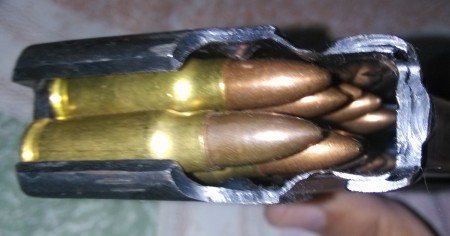
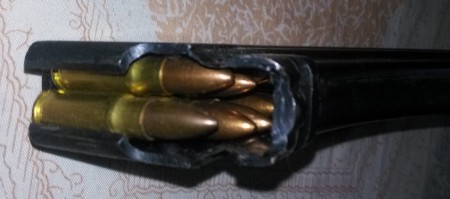
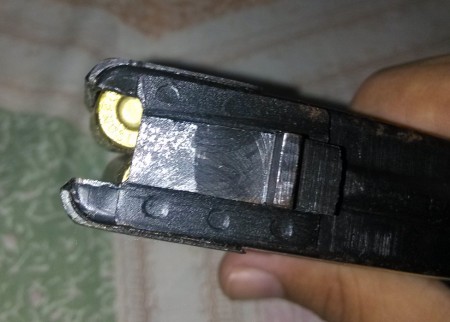
I was curious to try this out firsthand, so I dug out some various AK magazines and some 7.92x33K cartridges to see for myself:
Adi in Pakistan also sent a couple photos of some of his ammo:
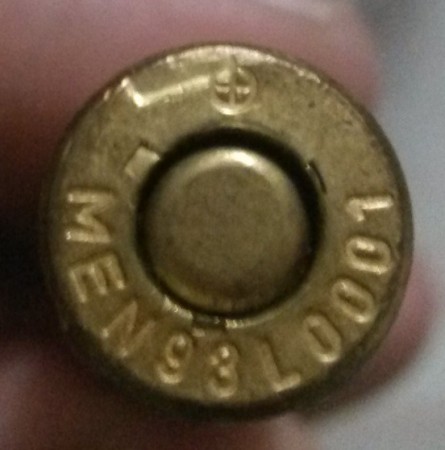
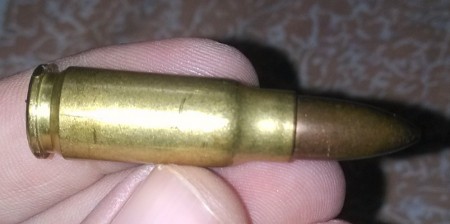
My understanding is that local 8×33 in Pakistan is made from a variety of cases, primarily 8×57 and 7.62mm NATO. Both are presumably fairly common in military use, and close enough in case head dimensions to reform into 8×33. This particular round began life as German 7.62×51, with a Berdan primer. Based on the ejector mark on the case head, I suspect the round was initially fired from an HK91, which is a fairly common military rifle in the area.


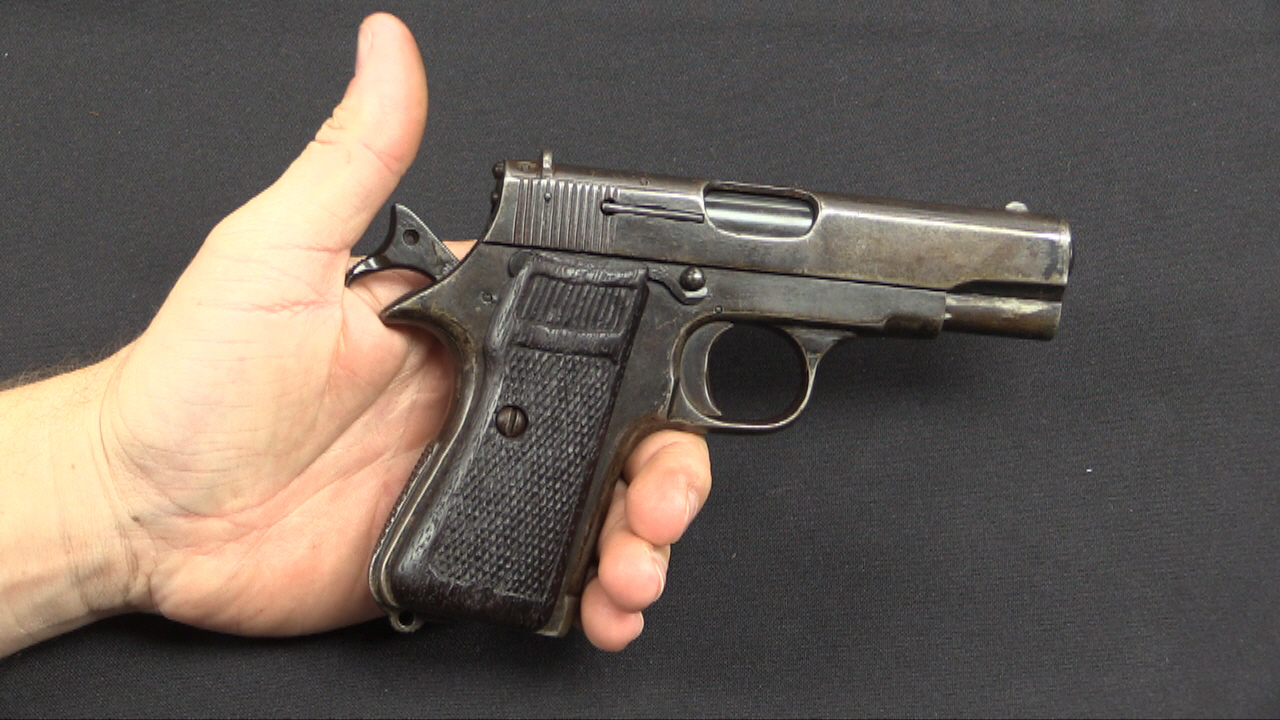
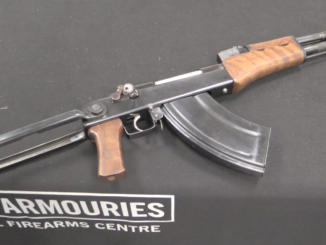
Great bit of information, timely, and in keeping with ages old tradition of making weapons that work, by hand, out of what is left by the dead on the battlefield.
This is “Khyber Pass work” no different today, than was practiced three hundred years ago, and we, Americans, should take some real lessons home with us. These folks don’t wait for “Lake City” to show up out of the ass end of a C-130, stacked cubic on pallets, they take what they can pick up, along with what they’ve collected, knowing how war takes place, and they get the job done.
This is a great job, opening eyes, expanding minds, glad to have this bit of info show up regularly.
Semper Fidelis, John McClain, GySgt, USMC, ret.
I couldn’t have said it better myself. Thanks, Gunny!
Okay, it’s time for a Khyber Pass 8×33 Kurz. You’re lucky not to have to forge the entire gun, as most Khyber Pass pieces made by inexperienced smiths aren’t fit for service due to the parts not being strong enough to handle firing stress.
That is great Ian. I am here if somebody wants to ask any question about the rifle or need any particular pictures of it. Keep in mind that I am just an average Joe.
BTW, I hope someday Forgotten Weapons will do an article on Parker Hale rifles. I bet a significant portion of the American firearms community has not handled any one of them.
Hi, Adi :
Thanks for sharing your information, and for the great photographs. Incidentally, having read your previous posts, I must say that you write very well.
Thanks Earl. Well, that is what happens when one’s country has a colonial past and a society which cherishes English way above its native tongue.
It doesn’t change one’s ability to express oneself fully, regardless of the language medium. If one is able to do so in one’s native tongue as well as the English language, or any other language or dialect for that matter, then one has succeeded in communicating the vital essence of the conversation to others, linguistic and cultural nuances and all included.
I think the old Colonial heritage, both at once a source of great pride and sometime antagonism as well as internalized agonizing, certainly does have its positive and negative aspects, but in the end it is what one makes of it that matters.
I get where you are coming from. A good prose incorporates the subtleties of expression clearly and precisely which is a universal trait in any language. No wonder I have ‘The Elements of Style’ right by my bed.
But I was also hinting towards a common trend in post colonial states who develop a lingering sense of inferiority about their mother language. I have never heard of a scientific paper written in Urdu. Maybe there are some but I am not aware of any. A crucial part of vocabulary is missing because after a certain level of education, English was exclusively used. If the Germans and Japanese can get by without English,
should we too? I think we should balance things out. English is a universal language today. We cannot leave it but the growth of the vernacular should not be hindered.
P.S. I think I am getting too poetic here but you get the point.
Oh, not too poetic at all, Adi. There needs to be a balance between wide communication and regional pride… I’m among the Americans who envy anyone with fluency in more than one language, especially one that is part of their heritage. (My grandfather’s family, despite generations in Iowa, spoke German at home until 1917, but by the time I was a kid he had completely lost his hearth language.) There’s a dialect of French that no Frenchman can understand that is still hanging on in Louisiana, to the pride of the Cajuns, and God bless the Scots and Irish for hanging on to their Gaelic.
But on the universal language – and one of the things I love about this site is that as both a weird-gun nerd and a weird-book nerd there’s a rare overlap here – here’s a link to something I heard about last week that might interest you:
http://pri.org/stories/2013-11-13/one-reader-197-books-one-year-finish-them-all
A Brit writer decided that she needed to branch out from English and American authors so she set out to find and read at least one book (in English) from every country in the world. In a year. This was complicated by small countries that had never produced a book in English, but local authors were kind enough to send her unpublished translations of their works. Included is probably the most incredible reading list I’ve ever seen, and a fantastic time-lapse photograph of the project’s evolving bookshelf.
Thanks for a fascinating post and conversation.
Hi, Jim :
Thanks for the great link to Ann Morgan. I seem to recall listening to an NPR / PRI interview with her regarding this project not too long ago. Nice to be able to reconnect with her project, though.
Per your November 19th, 2013 reply @ 10:04 p.m., I agree wholeheartedly. Further and parallel development of linguistic usage at that level would be very interesting in terms of its potential impact on cultural and social advancement.
I have a question. Why would you rechamber a Ak to usea an old “forgoten” cartridge? 7.62×39 has to be the most commonly available amunition. Is 8×33 easy to find in pakistan?
Ak was rechambered to 8×33 Kurz because, like many other countries, standard AK 7.62×39 round comes under prohibited bore. You might have heard of some fairy tales of Pakistan being a heaven of firearms, which in certain areas is true, but getting a firearms license even for a non-prohibited bore is quite a chore. Currently, Ministry of Interior of Pakistan is ‘officially’ not issuing any new license.
Of course with a little arm twisting, extra cash in hand, a friend or family in the concerned governmental department or a benevolent politician can get you to even hoist an anti-aircraft gun on your rooftop legally. In other words, there are no normal channels. People just consider those ‘extra fees’ part of the process. If you are looking for a seminal model to study institutionalized corruption and nepotism, Pakistan should be your first choice. Common man is the fodder this bureaucratic beast feeds and thrives on.
I am not saying gun ownership in Pakistan is not one of the highest in the world. Just that quite a large portion of those firearms are not licensed. Every home I know has 2-3 guns. Are they all licensed? I don’t think so. The situation is different in Khyber Pakhtunkhwa and Tribal areas where open carry is allowed and people can even legally own rocket launchers. The tribal belt was ,by treaty, responsible for its own security so they have owned and used all kinds of guns in the world without any issue. That is one of the main reasons why the arms industry of those areas has been so fruitful.
Adi … coild you please tell me how these Berdan primed cases are being de-primed, and what powder they are using? Very interesting. Any chance I could buy a couple empty cartridge cases??//Mike//
I don’t think I will be able to answer your questions but I will give them a shot.
I have never been to Darra area personally. Afghan war has made it quite difficult for one to visit unless he has heavy weight contacts there. As far as I know, de-priming is a simple job which is most probably done by kids with a hammer and some kind of protruding base to seat the cartridge on. The more unskilled a job the younger the age of the operative.
I don’t know how they are getting their powder. I know for sure that it has become quite difficult to acquire it as the government bundles it together with bomb making material. Darra ammo is generally considered to be not very good. People mostly use Norinco, Wah Ordinance or imported ammunition.
I wish I could send you some empty cases but if I do that, it puts me under unnecessary scrutiny as Pakistani customs routinely open any package going to a foreign country. However much I argue with them about the harmlessness of those empty cases, a customs officer after a bad day can take it in virtually any direction he wants.
War breeds insecurity, expediency, selfishness and acute cynicism. Unfortunately, Pakistan is no different.
Adi .. thank you so much for the answer, it helped. Your country is not alone in insecurity, expediency, selfishness and acute cynicism, at least your country has a valid reason; we don’t.
Hi, Kevin :
I have to say that I have the greatest professional respect for your postings as I know that they are usually based on real-world experiences, especially from your time in service in Afghanistan and the border areas. It is fairly obvious that you made the time and effort to really connect with the local people and at least try to understand their concerns and points of view, and perhaps to share with them not from an outsider’s standpoint, but as one with them. This is a rare yet invaluable aspect of “hearts and minds” ( I hope you’ll forgive the use of such a worn-out and trite phrase ) that has all too easily been ignored under the present circumstances.
Thank you for sharing this hard-won and invaluable information so that the rest of us might also try to understand.
Well said, Thomas, well said — as can only be so with the experience of the “school of hard knocks”, time and hard-won introspection.
Hi, Thomas :
Please disregard my “reply” of November 19th, 2013 @ 5:07 p.m. It was intended for Kevin R.C. O’Brien. Sorry about the mix-up!
Great comparative evaluation, Ian — excellent presentation and technical assessment, as usual!
Side note for Andrew Chern, from a forty + year working blacksmith.
The smiths in the “Pass” area have been at their trade for several centuries and know a great deal about metalurgy.
They may not have the finest raw materials to work with, but they have learned to make what they have work.
If their products were poor or unreliable they wouldn’t be in business very long. Word of mouth goes a long way with the “Pass” customers.
Thanks, Bill. I understand your point. I guess I should have remembered that Imperial Japan had a similar issue. Even though they were short on good raw materials most of the time, the Japanese would try to give their troops the best stuff they could. “Last-ditch” Arisakas were generally not crappy, but they were very crude yet very lethal to their intended victims downrange. It turns out that the Arisaka rifles from the Type 38 and onward are among the strongest bolt-actions ever built (unless you count the 7/8 scale training rifles, not meant for front-line service).
In any case, if you’re going to buy a Khyber Pass Copy, be sure not to use full-strength ammo…
Andrew, when I was in that part of the world, Khyber copies were routinely used with all kinds of surplus ammunition, primarily in AK and PK copies. I never heard of one blowing up, but some would wear out, particularly sheet metal receivers elongating.
Of course, Saco Maremont had the same problem with M60s before that monstrosity was sent to the showers.
The AK/PK design is fairly ingenious in that the receiver sheet metal is relatively unstressed, so heat treating is not usually an issue. The loads are borne by the bolt, barrel and trunnions, much like the M16 series where the loads are borne by bolt and barrel extension and the receiver can be made of aluminum alloy because it’s unstressed, relatively.
But my point is that the guns produced at Darra Adam Khel (which was the main workshop town, in the Pakistani Pushtun tribal territories; the “Adam Khel” are a Pushtu aka Pathan tribe) and in other borderlands workshops are functional enough.
Please see my reply dated November 19th, 2013 @ 5:07 p.m. I think I may have accidentally posted it as a reply to Thomas. Sorry about the mix-up.
That is a truly relevant point, Bill!
I take it this would only work with brass casings? Was under the impression that steel cases could not be reloaded, but on re-reading Sharpe’s Handloading, he reported getting at least ten reloads per German WWII steel case–but noted that the inside of the necks would corrode quickly if not cleaned right away. So one could reload steel, but doubtful that one could reform it into a different cartridge (except maybe just cut it down to a straight wall cartridge).
Impressive work, especially if the locals make their own resizing dies. If the powder is non-canister powder taken from other cartridges, pressures could get interesting, but maybe the AK is over-built enough to handle it.
There seems to be a so-called “universal” gathering of opinion that steel-cased cartridges cannot be successfully reloaded, but in actuality this is far from true. Steel cartridges can be successfully reloaded, but one has to be aware that different parameters apply vis-a-vis brass cartridges, for obvious metallurgical / structural reasons.
Here is one link, among many others, concerning the subject at hand : http://www.cheaperthandirt.com/forums/posts.aspx?postID=37906 dated 052913 and referenced 021813.
Another link that is related directly to the above-mentioned item is as follows : http://www.gunholstersandgear.com/2013/02/14/reloading-steel-cases-reload-steel-case-ammo/?utm_source=GunHolstersAndGear+Newsletter&utm_campaign=926!acc4e7-RSS_EMAIL_CAMPAIGN&utm_medium=email.
There are many other web-based articles detailing reloading of steel-cased cartridges, but these are a good start.
of course you happen to have a bunch of 1944 7,92×33 ammo handy 🙂 I imagine it would not be to hard to cut down the follower a bit and have some filler in the back of the magazine, if the position of the rounds is a problem. If that’s no problem, don’t bother with it 🙂
@K!P
You don’t even need to cut anything and put fillers anywhere – what you need is a Polish grenade blank magazine, if you can suffer it being only 10 rd, that is. It has a factory (front) mounted filler and factory (front) shortened follower, and are generally available at, like, 10-15$ each for a brand new one on the Polish auction sites and on-line shops, e.g. http://abaddon.otwarte24.pl/2795,AK-GN-magazynek-10-nabojowy . Sometimes they even make it to the Gun Broker, but American sellers charge WAY more, like fivefold, per unit). Polish grenade blanks are 48 mm long, just 1 mm shorter than the 8 mm Kurz – so the magazine with an insert should work just perfectly.
Ive seen this video: http://www.youtube.com/watch?v=FinRqCocwGE about the pakistani gunmakers and guntraders, and i was surprised to see generous amounts of 8×33 cartridges.
Please do make your own 44 bore AK. That would be so cool.
The G3 was (and for all I know still is) an issue weapon in Pakistan and was locally produced by Pakistan Ordnance Factory. The ones I handled were all out of Pakistani control and were well worn, but appeared to match G3s and AG3s I’d shot before (German and Norwegian) and differed really only in markings, and in some very minute details of machining that let the tech intel guys tell which was which even if you shuffled the parts.
The G3 grip also appears on the Pakistan-issue RPG-7. It’s a very distinctive grip, as all you who have handled an HK roller-locker can attest. The Pakistani ones I personally saw were all green.
Both the G3 and RPG turn up with absolutely no markings on them, but various details that marked them as POF made, not Khyber workshop work. Our assumption was these oddities were deniable arms made for clandestine purposes, much like the 1960s Chinese M20/M21/M22 guns that I suppose most of you guys are familiar with. Like the Chinese guns they fail any true deniability test, but provide a bit of smokescreen. For example, a lot of M2x guns used to turn up in the hands of African guerillas, and Chinese diplomats would go all Alfred E. Newman, “Who, me?”
The twists and turns of long-term historical and political intrigue in that part of the world have probably given rise to more such “anomalies” and the like than one could imagine. Good to see a definitive take on at least one aspect of this jigsaw puzzle from someone who actually has been there — an invaluable piece of information that is greatly appreciated, to say the least.
The original thread for this discussion seems to be frayed into several channels, giving me an opportunity to ask for advice for my 7.92X33 StG Mag problem. Hopefully someone may have an answer to the below (6) problem.
Having purchased an original fully functioning MP43 (included one original magazine functioning perfectly), several months ago I ordered, via the internet, six new mags (probably newly manufactured in Germany). The mags were marked “MP44” on one side and “fxo” on the other side and were blued but felt slightly lighter that my one original StG mag. The six newbees had two problems. They would not fit into the StG’s magazine well! I had to file-down the sides of the mags to get them to fit in my gun! I now can get them in and seated, but only after man-handling them (force); they are tight to in-sert and ex-sert (that’s not good in a “fire-fight!”). The other problem was they failed to feed properly especially when loaded with 30-25 rounds, I’d get several double feeds, and failures to feed when the mags were close to being fully loaded! After conversing with the international class III community via emails, the consensus was to get a jeweler’s file, disassemble each mag, and file down the weld splatter inside each mag. This I did and the unfortunately the feeding problem continued with no improvement. I tried only loading the mags, with say 25-24 rounds, and the first few rounds continued to improperly feed. It is less of a problem when there are only, say, 20 rounds or less in the MP44/Fxo magazines. The latest thing I did was to pay the affluent price and purchased an original magazine. It worked perfectly just like the one that came with my MP43. What to do with the six Fxo mags?
Is it possible that the magazine follower is tilting excessively under the circumstances you mentioned?
I doubt it – the AK follower design really can’t tilt. However, through the clear magazine you can see that the top half dozen of so rounds aren’t quite sitting at the right angle.
@ Adi & Jim In Houston :
A bit off-topic, I know, but if you haven’t already read it, an excellent book that deals with men at war as human beings at a very deep and realistic level is John M. Del Vecchio’s “The 13th Valley”, based on the author’s own experiences as an embedded war correspondent with the 101st Airborne Division during the worst of the fighting in the A Shau Valley in Vietnam long before such a term was coined.
There are several sections within the book that delve into the full impact of language and its nuances, how significantly it is a product of our thought processes ( and vice-versa ), and how it drives our behaviors in an infinitely more profound manner than we realize.
The only other such book of many I have read that communicates so powerfully about the depth of the human condition in all its magnificent and terrible sweeping panorama of exaltation, introspection, agony and despair is Pierre Schoendoerffer’s “Farewell To The King”.
Both books are still available in hard cover and paperback form on Amazon if anyone is interested.
I am still really failing to see the point of this. Surely 7.62x39mm is not hard to find?
Look at it this way. Is it hard to find or make full Auto AKs? Why most of the American civilian market has to contend with semi-auto assault rifles?
The answer is the same for someone using a old World War II round in place of a conventional one in Pakistan.
BTW, I have heard that Pakistani government banned this 44 conversion in 2012.
It may not have been hard to find, but it was a lot harder to legally own. By rechambering the rifle for 8×33, is became much simpler to legally possess. Like the shortened .50BMG used for rifles in California to avoid the .50 BMG ban.
The Pakistani govermnet apparently caught on to the idea in 2012 and added 8×33 to the prohibited list, though.
If someone made a STG44 in 7.62x39mm that took AK mags I could see that was a good exercise!
@P.Cassel
Maybe stupid solution, but could stronger mag spring somehow help?
I am common thinking that spring when fully compressed has lower strength to push the topmost cartridges. Maybe I’m wrong ?
For example put spring from AK mag or something like and try.
Or have you tried this? ;
disassemble your original STG magazine and than put follower and its spring in these “new” fxo STG mags… maybe it’s the problem in improper follower design.
And vice versa, put new followers and springs in old STG mag and see how they work.
And do not forget that magazines are probably the hardest parts of any firearms to manufacture reliably.
I remember seeing a comment here, or on gunlab, that some US commercial producers never let any facility “gun enthusiast tourist” visitors to, even accidentaly, stumble on their magazine works and see what’s cooking in there.
It is still, lets say, a kind of a trade secret.
I guess that these FXO manufacturors you bought from 6 mags didn’t grasp that skill extremely sucessfully…
@Mike
I remember reading on some forum story from a guy that claims that in the early ninetees, he was a part of a team that inspected newly opened East German Army (or some kind of “people” reserves??) armories.
He claims seeing a lot of crazy stuff there, among other lots of STGs rebarreled to 7.62×39 and reworked to use AK mags, all done of course after the war to utilise lots of STG leftovers.
I can’t say if this is a true story, care must be taken especially as he told some other stuff that sounds initially not plausible; like guy was involved in a deal trying to sell some kind of full auto VG1-5 type rifles to unknown african countries, during the Cold War (to sold them the “simple” technology to make the rifles – but soon Africa was flooded with AKs so it failed, by his story).
As for first, I’m sure Michael Heidler (if he is reading this) could clarify about these east german reworked STGs, is it a myth tale, or somewhat true.
dear ian , 8×33/ so called 44 bore pakistani guns are specifically chambered for the cartridge made on an Ak style platform , some old Aks are also chambered to accept this cartridge, if u r using an ak magazine then the feed lips are modified to run the wider stubby cartridge smoothly and usually 25 cartridges are recommended to load or less, however pakistani gunsmiths have made special magazines that are straighter and are able to accept thr 8×33/44 bore cartridge . they are also shorter like the stg magazines . some guns only take these specific magazines made for 8×33 cartridges . these guns are well made with milled recievers and proper weapons grade steel rod barrels and are good to shoot , comparable to good quality weapons however the barrels lack any chrome linings etc so are rusted easily , gone are the days of files and hammers to make guns now proper machines CNC aided are used so gun quality at derra adam khel is much better . for a cheap price of 150 dollars i think the guns provided are of better quality than anticipated ,
please do some videos on some pakistani made bolt action rifles that are made of SMLE or mosin or mauser actions and also that are made as combination of all these actions which have smle bolts and mosin type trigger groups and so on ,
please also make a video on khyber pass or pakistan made webley revolver copies that were copies and also those which were made on actual british blue prints , and also on pakitani shaheen and sikandar and ikhlas brand shot guns these were once top class international standard shot guns no longer in production and were exported also , long forgotten by most
Balochistan
It sounds like Adi’s 44-Bore rifle is quite a unique piece! Adapting an AK to use the 8×33 Kurz cartridges by reaming the chamber is an interesting modification. The fact that it still utilizes standard AK magazines and can hold 28 rounds is quite practical. Adi’s observations about occasional feed issues due to the shorter case length make sense, considering the AK’s original design around the longer 7.62×39 cartridge. The photos he shared would be fascinating to see to get a visual on this modified rifle. Thanks for sharing this insight into a lesser-known variant of the AK platform!Przy okazji chciałem polecić sprawdzoną stronę o hazardzie i rozrywce: automaty barowe za darmo dla polaków